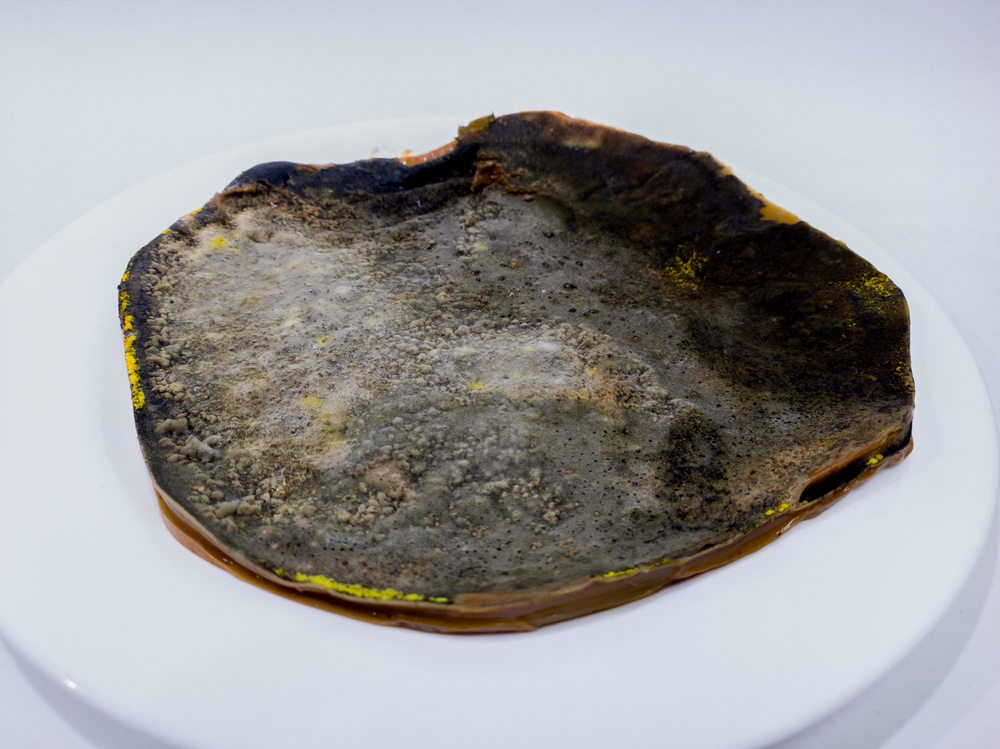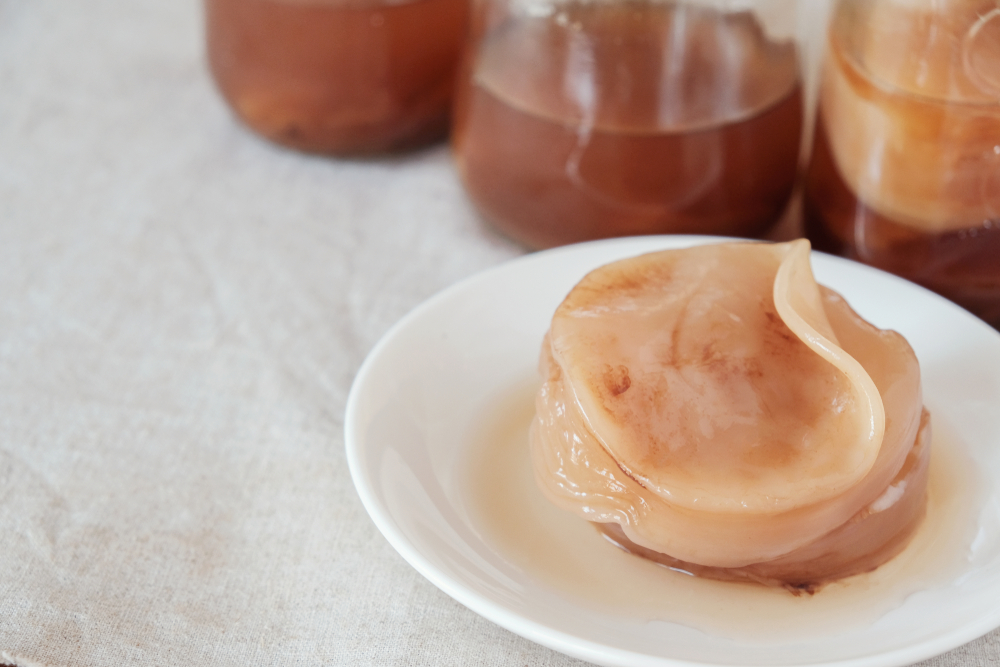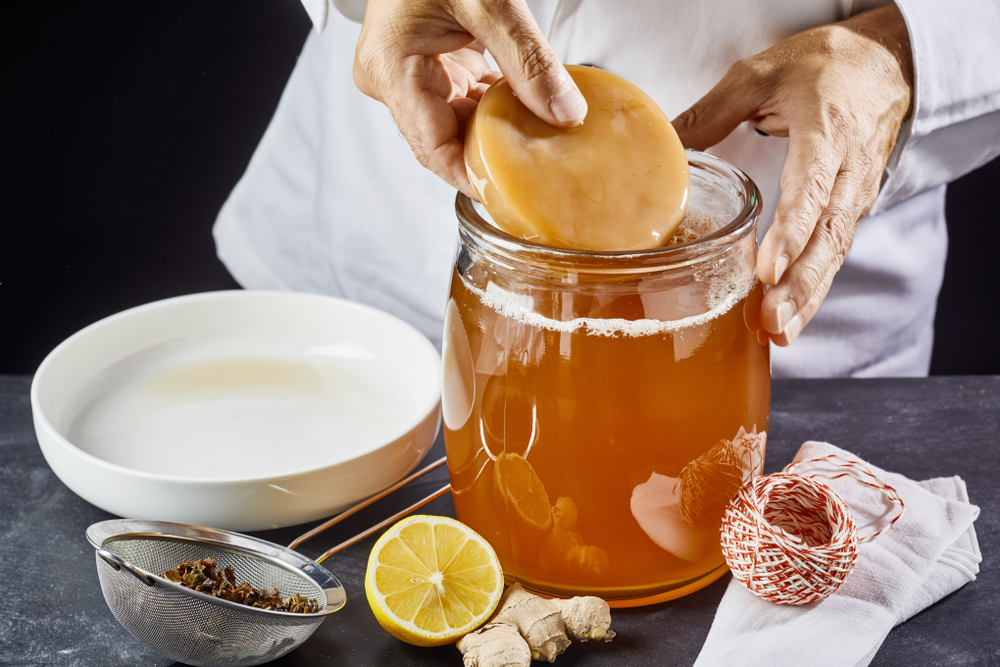A healthy kombucha SCOBY can come in different sizes, shades, and shapes; no two are exactly the same. However, you should avoid brewing with a black SCOBY or one showing distinct signs of mold.
Table of Contents
How Do You Know If Your SCOBY Is Healthy?
A robust Symbiotic Culture Of Bacteria and Yeast has three distinct characteristics:
- Proper coloring
- Steadily expands in size
- Slippery texture
A few dark streaks in your new SCOBY are nothing to worry about—these dark patches are likely the black tea or green tea remnants stuck to the SCOBY.
The size of a healthy SCOBY is about one-fourth to half an inch thick. Healthy SCOBYs sometimes sink to the bottom of the jar or float in the middle of the homemade kombucha. If your SCOBY is steadily growing and produces carbonation, it’s a sure indication that things are going as planned in its container.
Furthermore, a SCOBY is resilient upon touch. If it breaks off after a gentle pinch test, it’s not healthy. However, if it stays in shape, it’s healthy and can likely brew a good batch of kombucha.
What Color Should a SCOBY Be?
A healthy SCOBY has a light color, anywhere between white to a golden tan. If you used a darker tea, like black tea, the SCOBY may take on a slightly darker hue—but not completely black.
A darker SCOBY doesn’t necessarily mean it’s unhealthy; it usually just means it’s getting older. If it doesn’t produce baby SCOBYs during the first fermentation or if it’s black, it’s likely dead.
That said, not all kombucha batches get to live that long. Molds can form if the kombucha brew isn’t adequately sealed. The molds can be blue, green, or white and are distinguished by their fuzzy and off-putting appearance.
If the SCOBY shows any signs of mold or is dying, it’s best to discard the entire batch and start the fermentation process anew.

What Texture Should a SCOBY Be?
A SCOBY is soft, rubbery, and slippery. It has a bouncy texture similar to a gummy bear or an uncooked squid. It will not disintegrate when pinched.
There may be some stringy residue clinging onto some SCOBY discs. These are the colonies of yeast and are perfectly normal.
5 Signs of an Unhealthy Kombucha SCOBY
An unhealthy kombucha SCOBY is typically unsalvageable. If you want to keep your kombucha tea batches rolling, throw out the SCOBY and replace it with a new one.
If you’re unsure about the signs of an unhealthy SCOBY, here are some of its most notable characteristics:
- The fermented tea smells bad. Not just vinegary sour, but something akin to rotting bacteria. Cut your losses and start a new batch if your kombucha culture smells bad.
- Moldy SCOBY. Just like in most food and drink, if there are signs of mold, keep it away from your mouth! Molds are green, blue, and black and rest atop the kombucha brew or directly on the SCOBY.
- The SCOBY isn’t producing. A healthy SCOBY usually forms a baby SCOBY on the brew’s surface when fermenting. However, if the process isn’t producing any more SCOBYs, it could be a sign of one of two things: its environment is not ideal, or your SCOBY is dead.
- The kombucha’s pH level is too high. Kombucha must stay within 2.5 to 3.5 pH for consumers to reap its full benefits. Any higher, and you’d risk contaminating the drink since there’s not enough acid to slow bacterial growth.
- The SCOBY is black. This is a major sign of a dead SCOBY. It lived its life, and now it’s time to let it go.
How to Keep Your SCOBY Healthy
It’s easy to overlook the fact that SCOBY isn’t just a blog of goo—it’s a habitat for millions of living bacteria and probiotics.
Here are a few ways you can keep a SCOBY healthy when making your own kombucha at home:
- Peel off the top layers of SCOBY after four brews to prevent overgrowth.
- Ensure that starter tea and SCOBY proportions are ideal for kombucha fermentation.
- Keep the kombucha at room temperature, about 68 to 78° F.
- Avoid placing the SCOBY near a trash can.
- Use a cheesecloth or paper towel to “close” the jar and avoid fruit flies contaminating your brew during fermentation.
- Don’t remove the stringy bits of yeast that dangle from your SCOBY.
- Keep the fermenting jar in a place with airflow.
- Use filtered water for the sweet tea.
- Store the SCOBY properly when not in use.

When Can You Expect a New Baby SCOBY to Form?
A baby SCOBY can form on top of the mother SCOBY every two to four weeks. It’ll be thin at first, and its shape depends on the container where you put your culture.
But after some time, it’ll grow and become the familiar SCOBY pellicle we all know and love. If you want to separate it and put it in a new container, gently cut the thin SCOBY with sanitized scissors and lift it out of its current container. Then, put it in a new one, or store it in a SCOBY hotel.

